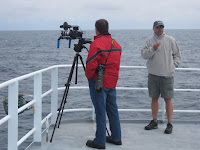In one of our hydrothermal vent dives, we have seen an USO! With my expression "Unidentified Swimming Object" :)

So, what happens when a scientist comes across an unknown specimen?
First of all, let's start with a fascinating fact:
More than 95% of the underwater world has not been explored yet!
Can you believe that?! 71% of the earth's surface is ocean and more than 95% of the volume of the oceans remains unexplored!! ...which feels like we are living on a pretty unknown planet and there is so much to explore!
For a scientist on land, maybe it is unlikely to discover a new type of bird, but given the unexplored percentage of the oceans, there must be so many new species waiting to be discovered in the oceans!
That is what happened when we were having a ROPOS dive. A beautiful red jellyfish, here it is better to not to assign a name to it, since we don't really know what kind of species it is.
Taxonomy is the science of naming organisms.
When marine scientists see an unfamiliar organism, they need to compare it with the descriptions of the known ones in taxonomy. For instance, in this case NEPTUNE and VENUS teams will check whether this beauty has been already described in taxonomy. If the teams cannot find an exact match, a specialist will be contacted to identify the species, if it is known, or even to create a new species name. Naming new species is actually a tedious process:
1. The scientist must provide a description in detail.
2. The scientist must provide two physical samples for the new specimen. The first physical sample is called the holotype and the second physical sample is called the paratype.
Holotype: The physical sample of the specimen used for the original description of the specimen
Paratype: The physical sample of the specimen to use as a back up of holotype.
3. The scientist writes an academic paper on the morphological description of the new specimen.
4. The
Barcode of Life works for identifying species, not with a morphological description, but with genetic barcoding. In the taxonomy process, this is optional for now, but it is becoming more standard.
More on
Barcode of Life.
As an important marine science note:
Census of Marine Life catalogues and provides the biggest framework about diversity, distribution and abundance of marine life, while investigating the past, assessing the present and forecasting the future. It is worth to visit
Census of Marine Life!
 |
| I could name it jellyfish the sunflower :) |
Goksenin Sen
Marine Educator


















































